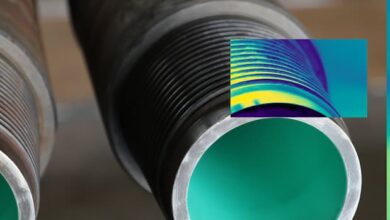Company taking aerospace alloys to oil/gas
By Linda Hsieh, assistant managing editor
It’s estimated that less than 1% of the oil and gas market uses aluminum drill pipe (Al DP). Although there are many claimed benefits – primarily its lighter weight vs steel – the higher costs involved have generally confined the pipe to niche applications.
But Alcoa, one of the world’s largest producers of aluminum, believes that the market may finally be ripe for accepting Al DP, pointing to the industry’s move into ultra-deepwater and the increasing necessity of complex, extended-reach wells to reach remaining reservoirs.
According to the company, alloy drill pipe’s higher initial cost is more than offset by savings during operations. Rig capacity can be upgraded by 50% to 100%, they say, and trip time, rig-up and transportation costs are reduced.
Alcoa is already widely known for its alloys in the aerospace market, yet its oil and gas business unit is only recently established – just within the last few months actually. Business development manager Mark Davies said the company is working aggressivly on two Al DP options for drilling, the 2014 and the C405, with current and planned field trials for both pipes in early 2009.
The 2014 was first developed as an alloy for aerospace back in the 1920s and was briefly used in oil/gas drilling in the early ’80s before the price of oil cratered, halting its progress. Now, with extended-reach wells and hard-to-reach reservoirs, the company believes there’s a renewed need for aluminum drill pipe
“A lot of these rigs can’t hold that much weight as far as steel. They’re trying to find something that’s comparable to steel as far as strength and durability, and be able to drill down to these reservoirs that they haven’t been able to reach before,” Mr Davies said.
Modern processing techniques have improved the pipe’s fatigue resistance and made the properties more consistant, though the basic chemistry remains unchanged.
In late February 2009 the company embarked on a monthlong testing project for the 2014 pipe at the Baker Hughes BETA facility in Tulsa, Okla. Alcoa hopes that the tests, at an approximate total cost of $500,000, will yield an extensive data set to prove the pipe’s potential.
Fifteen joints of the pipe will be put into the ground with different bits and hole openers. They will look at collapse resistance, torsional strength, axial and lateral vibration, bending movement, internal and external pressures, temperature, rate of penetration, weight on bit, standpipe pressure.
They’ll also test the aluminum pipe in so-called mixed strings, he added. For example, steel pipe may be used primarily in a well, with aluminum drill pipe used just to build the curve section. Al DP will be run mid-string and at the top and bottom “to see how it holds up,” Mr Davies said. “This is something we’re extremely excited about.”
For the newer C405 pipe, the company plans to test that design in an Alaskan project as early as mid-March. Like the 2014, the alloy used in the C405 was also initially developed for aerospace applications. Compared with the 2014, the C405 has 30% higher strength but less corrosion resistance. It also does not perform as well under high temperatures as the 2014 – which the company says has “operated satisfactorily in wells where the bottom hole temperature was 400°F.”
“The efficient heat-conducting properties of aluminum drill pipe aid the normal transfer of heat away from high temperature zones, thus reducing the danger of exceeding allowable temperature of the metal. Actual string temperatures appear to be 100°F-150°F lower than bottom hole temperatures,” according to the company.
Mr Davies commented that while Alcoa has decades of experience creating lightweight, high-strength alloys, entering the oil and gas market has required some adjustments.
In the airline and defense industries, “things seem to go very slowly as far as development. In the oil and gas industry, people want stuff now,” he said. “It’s been a big change for Alcoa. The oil industry needs stuff 24 hours, 7 days a week, and they need it now. … Our engineers at the Alcoa Technology Center in Pittsburg are amazed at how fast they have to get results done.”




